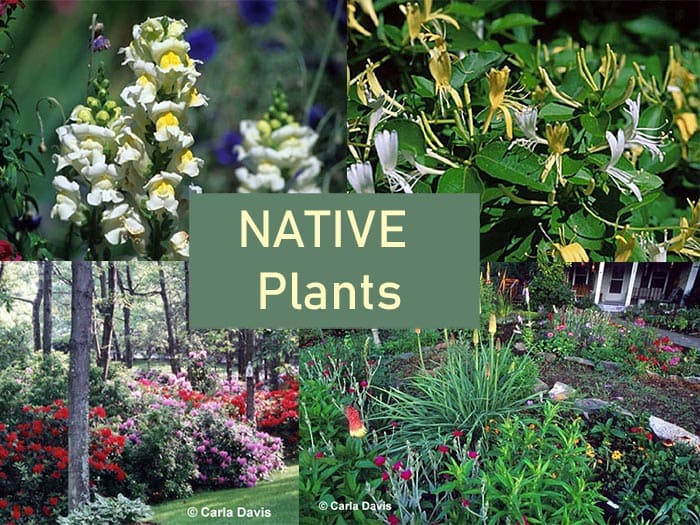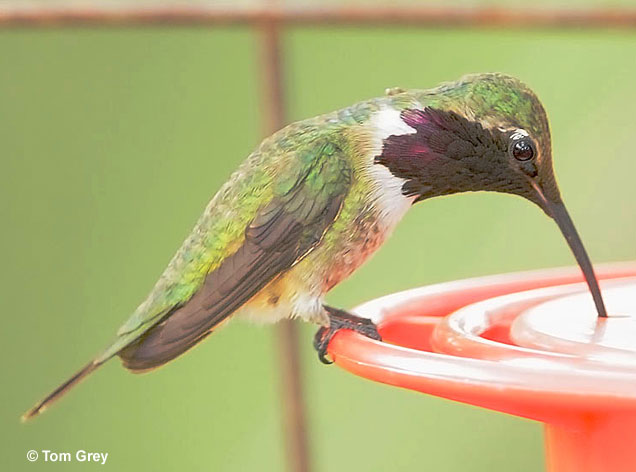
South Carolina Plants for Wildlife Habitat & Conservation Landscaping
Trees
Tall — Canadian Hemlock; White, Red, Chestnut and Post Oak; Black Cherry; Shagbark and Pignut Hickory; Red and Sugar Maple; Yellow Buckeye; Yellow, Sweet and River Birch; Beech; Tulip Tree; Sycamore; Red Spruce; American Linden
Medium/Small — Serviceberry; Eastern Redbud; Flowering and Pagoda Dogwood; American Holly; Southern Crabapple, Eastern Red Cedar; American Hornbeam; Washington Hawthorn; Common Sassafras; Sourwood; American Plum; Persimmon; Blackhaw Viburnum
Shrubs
Short — New Jersey Tea; Carolina and Swamp Rose; Cranberry; Lowbush Blueberry; Maple-leaf Viburnum
Medium — Red and Black Chokeberry; Sweetshrub; Silky Dogwood; Hazelnut; Bush Honeysuckle; Common Winterberry; Mountain Laurel; Spicebush; Sweet and Flame Azalea; Elderberry; Coral Berry; Highbush Blueberry
Large — Tag Alder; Mountain Winterberry; Mock Orange; Smooth Sumac; Silky Willow; Arrowwood
Wildflowers
Butterflyweed; Carolina Phlox; Wild Columbine; Jack-in-the- pulpit; Swamp Milkweed; White and Late Purple Aster; Wild Indigo; Pink Turtlehead; Coreopsis; Joe-Pye Weed; Shooting Star; Wild Geranium; Sunflower; Jewelweed; Blazing Star; Cardinal Flower; Bee Balm; Black-eyed Susan; Winkle-leaf Goldenrod

In South Carolina, Hummingbirds are commonly seen when you go bird watching.
Groundcovers
Wintergreen; Wild Ginger; Mouse-eared Coreopsis; Partridge Berry; Chalice, wild Blue and Creeping Phlox; Foamflower
Vines
Dutchman’s Pipe; Crossvine; Trumpet Creeper; Virgin’s Bower; Coral Honeysuckle; Passion Flower; Fox Grape; Virginia Creeper; Coral Honeysuckle
Grasses
Indiangrass; Little Bluestem; Eastern Gama Grass; Bottlebrush Grass; Broomsedge; Switchgrass; River Oats; Oat Grass; Pennsylvania and Plantain-leaved Sedge; River Cane
Three geographic land areas define South Carolina; the Atlantic Coastal Plain, the Peidmont, and the Blue Ridge region. Two-thirds of South Carolina is covered by the Atlantic Coastal Plain, from the Atlantic Ocean extending to the west. The land rises gradually from the southeast to the northwest. An area of the Atlantic Coastal Plain, defined as extending from the coast about 70 miles inland, is referred to as the Outer Coastal Plain. This area is quite flat. Many rivers can be found in the Outer Coastal Plain with swamps near the coast that extend inland along the rivers. An area called the Inner Coastal Plain consists of rolling hills. In the central Atlantic Coastal Plain is an area of forested land called the Pine Barrens. On the western edge of the Atlantic Coastal Plain, running from the southwest to the northeast, is a line of sand hills. To the northwest of the Atlantic Coastal Plain is the Peidmont. The landscape consists of rolling hills; gentler in the east and more hilly to the west and northwest. The Blue Ridge covers the northwestern corner of South Carolina. Part of the larger Blue Ridge that extends from southern Pennsylvania south to Georgia, the South Carolina Blue Ridge Mountains are lower and less rugged than the mountains in North Carolina. The forest covered Blue Ridge Mountains of South Carolina rarely exceed 3,000 feet above sea level. The Southern Appalachian Botanical Society can provide lists of plants for a specific region.
For more information on improving your wildlife habitat, visit the WindStar Wildlife Institute web site. On the web site, you can also apply to certify your property as a wildlife habitat, register for the “Certified Wildlife Habitat Naturalist e-Learning course, become a member and sign up for the FREE WindStar Wildlife Garden Weekly e-mail newsletter.

